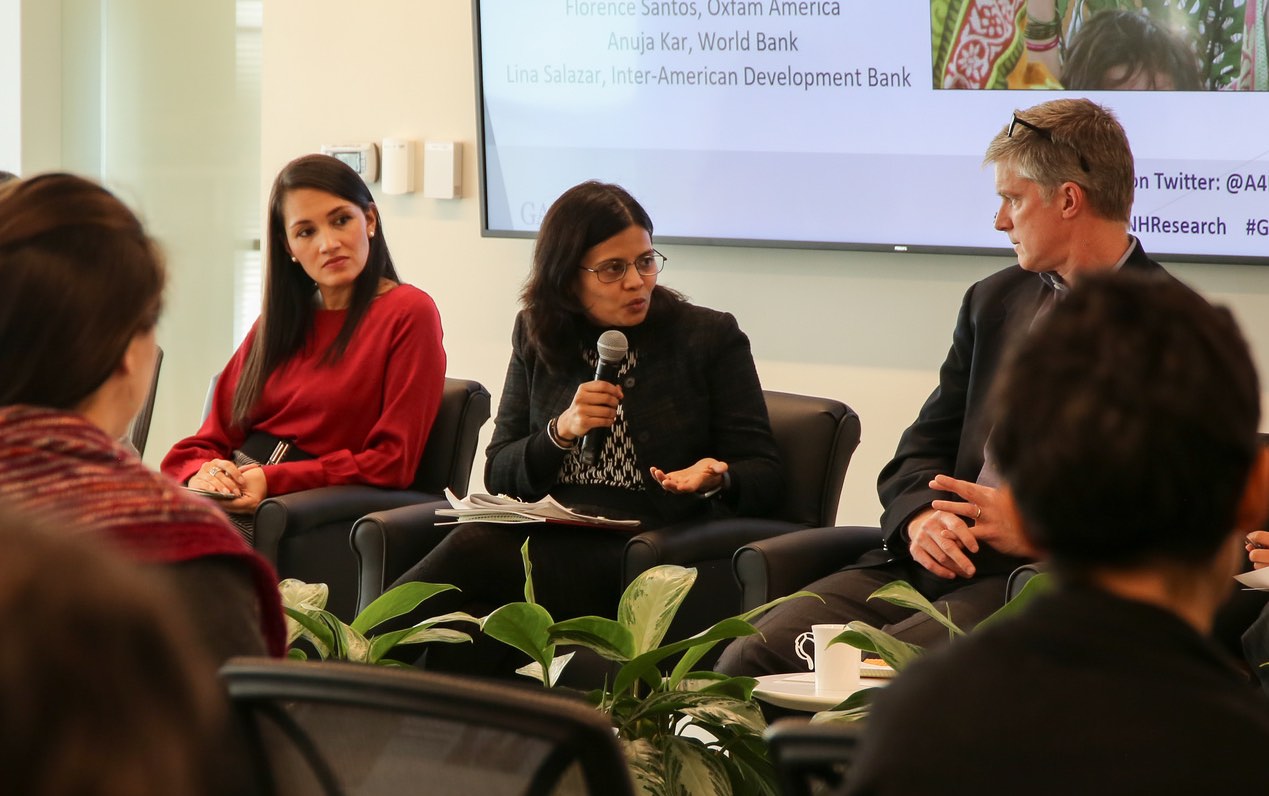When we talk about women’s empowerment, it is difficult to grasp what we actually mean. Does it refer to women’s attitudes towards gender violence? Or does it mean women’s economic independence and decision-making power? Does it perhaps imply access to productive resources, education, and other opportunities? Or might it mean control over time? Or does it concern all these aspects? Fortunately, in recent years, IFPRI, the U.S. Agency for International Development (USAID) and the Human Development Initiative (OPHI) have collaborated to develop a concrete means to measure these factors, the Women’s Empowerment in Agriculture Index (WEAI). The latest version of the index, the project-level WEAI (pro-WEAI), focuses on evaluating agricultural development projects. Users discussed its applications in a launch event Oct. 25.
When measuring the impacts of agricultural programs, we tend to focus on production and income (which, don’t get us wrong, is absolutely necessary!). However, sometimes we forget that agricultural projects can affect intrahousehold dynamics and improve (or worsen) the empowerment of individual household members. The index is a multi-dimensional indicator that considers five aspects of empowerment: Decisions about agricultural production; access and decision-making power over productive resources; control over use of income; leadership in the community; and time use.
In this post, we want to share two specific examples in which the Inter-American Development Bank (IDB), with the support of IFPRI, used the WEAI to assess the impact of agricultural projects on women’s empowerment.
The first example is a project In Nicaragua, the Agrifood Support Program (APAGRO). This program specifically targeted women farmers with high levels of food insecurity. It provided vouchers to purchase livestock assets (i.e. cows, chickens, pigs, and goats) and obtain technical assistance on livestock management, commercialization, associativity, and financial education. We used a randomized phased in and a difference-in-difference approach to measure the program’s impact on production and income. Our study showed positive, significant results. However, we wanted to go a step further and measure impacts on women’s empowerment.
Interestingly, it turned out that program participation indeed increased women’s empowerment! In fact, women participants were 5 percent less likely to be disempowered, and their disempowerment score was reduced by 7 percent. Also, within the household, we found a reduction in gender empowerment disparity, and the empowerment gap decreased (18 percent and 10 percent, respectively). This means that, because of the program, women’s empowerment levels were closer to those of their male counterparts.
Interestingly, the analysis shows that improvements in empowerment were mainly driven by participation or membership in community groups or agricultural associations, which could be related to the group training sessions organized by the APAGRO program to provide technical assistance. In fact, the women who participated in the training activities received larger benefits than the women who did not and these results were persistent over time.
The second example is a project in Bolivia: The Program of Direct Support for the Creation of Rural Agrifood Initiatives (CRIAR). This program provided technical assistance and vouchers that partially covered the cost of an agricultural technology such as irrigation, greenhouses, or storage units, among others. The program targeted small landholder farmers. Again, the results from the impact evaluation showed that beneficiary households improved agricultural productivity and consumption income. To measure women’s empowerment, we designed an agricultural household survey that incorporated questions to capture all five dimensions of the WEAI.
We found that 84 percent of the women in the sample were disempowered and 63 percent did not have gender parity within their households. The good news is that program participation reduced women’s probability of being disempowered by 37 percent and their disempowerment score by 66 percent. Thus, so far, the program appears to have successfully improved women’s empowerment. But what happens when we disaggregate the analysis by dimension? We found that CRIAR increased women’s access to credit and participation in credit decisions, augmented their membership in social and agricultural groups, and improved their time distribution.
However, the program also had some unintended impacts. First, the adoption of technologies reduced the time dedicated to agricultural work for both men and women—but only men experienced a positive effect on leisure. Second, we found that women’s participation in income decisions within the household decreased. After careful discussion with the project team, we were able to identify that this probably occurred because the ownership of technologies was mainly transferred to the male head of household, which implies that income generated with these technologies was considered men’s income. This shortcoming was addressed during the second phase of the project, which promoted joint-ownership of the technology by the primary man and woman of the household.
These findings from Nicaragua and Bolivia confirm that agricultural projects affect intrahousehold dynamics and may have unintended consequences that must be taken into consideration during all stages of the program cycle: Design, implementation, monitoring, and evaluation. Thanks to the WEAI, we have now a tool to measure women’s empowerment in agriculture! Currently, at the IDB, we are mainstreaming the WEAI in our land titling projects in Ecuador, Bolivia, and Peru. Stay tuned to learn more about our findings in these countries!
For more information on the WEAI and pro-WEAI, click here.
Lina Salazar is a Senior Economist and Jossie Fahsbender is a Research Assistant with the Environment, Rural Development and Disaster Risk Management Division of the Inter-American Development Bank. This post first appeared on the bank’s Sustainability and Climate Change blog.







